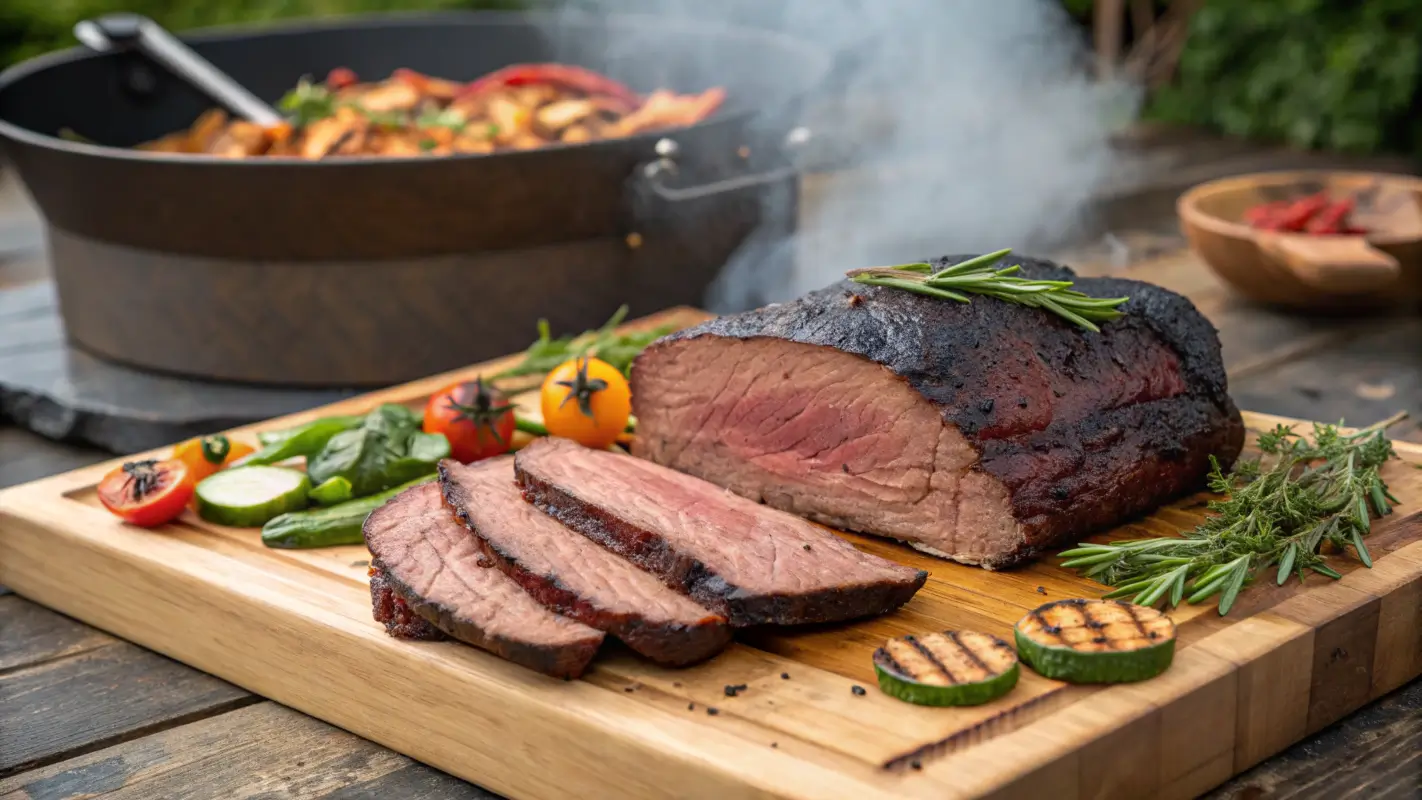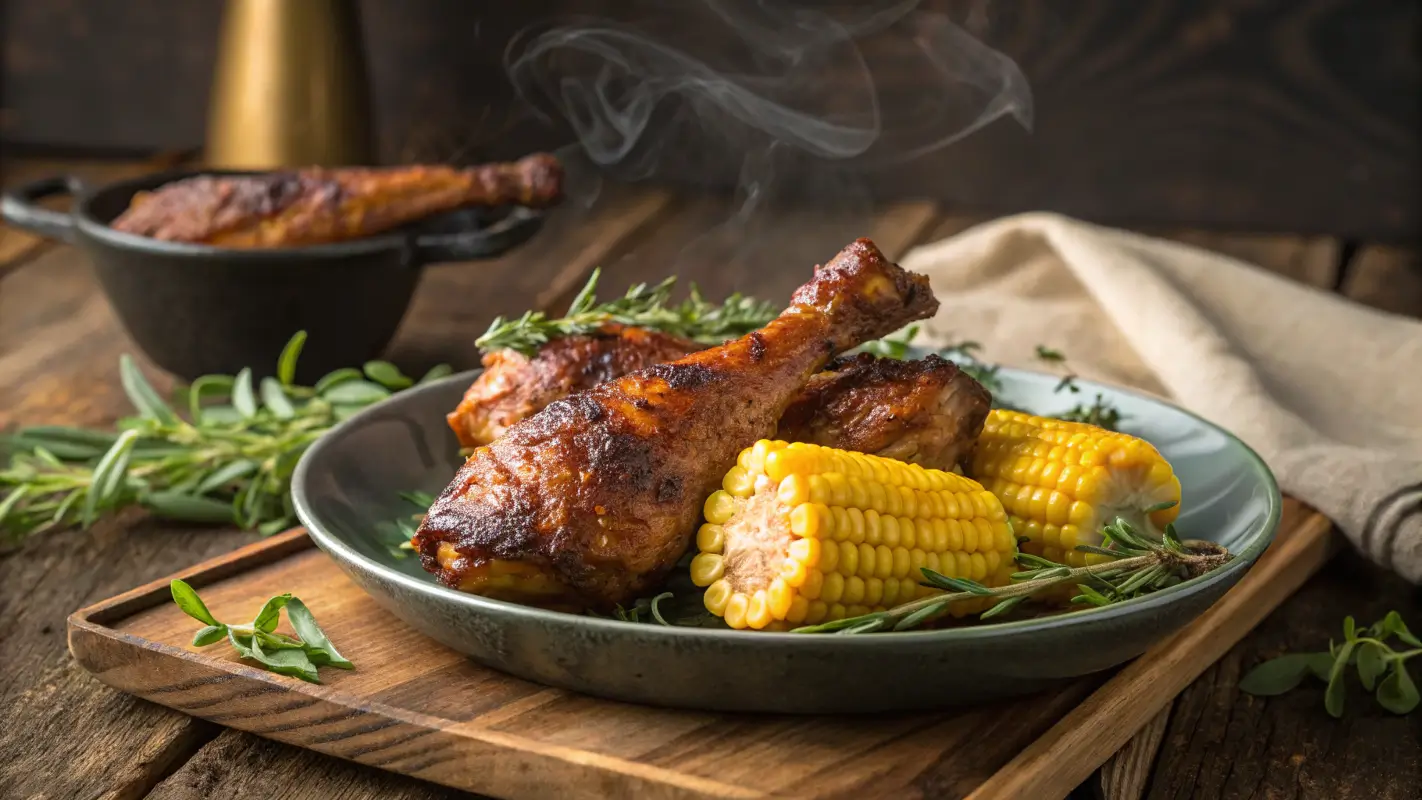Table of Contents
When it comes to grilling and cooking, there’s one method that stands out as both an art and a science: smoking. Smoker recipes are much more than just a way to prepare food; they’re a celebration of flavor, patience, and the magic that happens when heat and smoke meet. From tender, juicy meats to rich, savory vegetables, smoking is a technique that can elevate any dish.
In this article, we’ll explore everything you need to know about smoking food – from the basics of how smoking works, to the different types of smoker recipes available. Whether you’re a seasoned pro or just getting started, this guide will walk you through mouthwatering smoker recipes and techniques that will help you create some of the most flavorful dishes you’ve ever tasted.
Understanding the Art of Smoking
What Is Smoking?
Smoking is a cooking method that involves exposing food to smoke from burning wood or other materials. The process imparts a unique smoky flavor and is used to cook meat, fish, vegetables, and even cheeses. But smoking isn’t just about flavor – it’s also a way of preserving food, which is why it has been used for centuries across different cultures.
Unlike grilling, where food is cooked directly over an open flame, smoking involves cooking food at low temperatures over a longer period of time, usually between 200°F and 250°F. The smoke gently infuses the food, resulting in a tender, moist texture and a depth of flavor that you can’t get from other cooking methods.
A Brief History of Smoking in Culinary Traditions
Smoking food isn’t a modern fad – it’s been around for thousands of years! In fact, early civilizations relied on smoking as a way to preserve meat for long periods, especially before refrigeration existed. In ancient cultures, smoking helped prevent spoilage, while also enhancing the flavor of meats, fish, and even certain fruits and vegetables.
From Native American smokehouses to the smoking traditions of Scandinavian and Asian countries, the technique spread across the globe. Today, smoking is not only about preserving food but also about creating unforgettable flavors that can’t be achieved through traditional cooking methods.
The Science Behind Smoking and Flavor Development
You might be wondering, how does smoke enhance the flavor of food? Well, the science behind it is fascinating. When food is exposed to smoke, it absorbs tiny particles from the burning wood, which contain complex chemicals like phenols and carbonyls. These compounds interact with the food’s proteins and fats, creating new flavors and aromas.
The type of wood you use can dramatically impact the final taste of your dish. For example, hickory adds a strong, bold flavor, while applewood brings a milder, sweeter tone. There’s a whole world of wood options to explore, each offering its own unique flavor profile for your smoking adventures.
Types of Smoker Recipes and Their Uses
Choosing the right smoker for your needs is key to mastering the art of smoking. There are several types of smokers available, each with its own advantages and disadvantages. Understanding the differences can help you make the best choice for your cooking style.
Charcoal Smokers
Charcoal smokers are the classic choice for many barbecue enthusiasts. These smokers use charcoal as the heat source and often require a bit more attention to maintain consistent temperatures. They offer a traditional, smoky flavor that many consider to be the hallmark of true barbecue. However, they do require some skill in controlling airflow and temperature.
Advantages:
- Rich, smoky flavor that’s hard to replicate.
- Affordable and widely available.
Disadvantages:
- Requires more hands-on attention.
- Temperature control can be tricky for beginners.
Electric Smokers
If you’re looking for convenience, electric smokers might be the perfect option. These smokers use electricity to heat wood chips or pellets, making them easy to operate and control. With an electric smoker, you simply set the temperature and let it work its magic, making them great for beginners or those with limited time.
Advantages:
- Easy to use and control.
- Requires minimal attention once set up.
Disadvantages:
- May not produce as robust a smoky flavor as charcoal or wood smokers.
Pellet Smokers
Pellet smokers are a relatively new addition to the world of smoking, but they have quickly gained popularity due to their versatility. These smokers use compressed wood pellets as fuel, which are automatically fed into the firebox by an auger. Pellet smokers combine the convenience of electric smokers with the flavor of wood smoking.
Advantages:
- Easy to use with precise temperature control.
- Can create a variety of flavors depending on the type of wood pellets used.
Disadvantages:
- Requires electricity.
- Higher upfront cost compared to charcoal smokers.
Offset Smokers
For those who want to take their smoking game to the next level, offset smokers offer a traditional and authentic smoking experience. These smokers feature a separate firebox that is offset from the main cooking chamber, allowing for more indirect heat. Offset smokers tend to require more attention and experience, but they offer a classic, slow-cooked smoky flavor that is highly sought after.
Advantages:
- Classic smoking flavor that can’t be matched.
- Great for large cuts of meat.
Disadvantages:
- Requires constant monitoring.
- Can be difficult to control temperatures.
Essential Smoking Techniques of Smoker Recipes
Mastering smoking involves more than just setting the smoker and waiting. To get the best results, it’s essential to understand key smoking techniques that can affect your food’s flavor and texture.
Direct vs. Indirect Smoking
When it comes to smoker recipes, one important distinction is between direct and indirect smoking. Direct smoking involves placing the food directly over the heat source, while indirect smoking uses a two-zone method, where food is placed away from the direct heat.
- Direct smoking is great for smaller cuts of meat that cook quickly, like chicken drumsticks or fish.
- Indirect smoking is ideal for larger cuts, like brisket or ribs, which require low and slow cooking.
Understanding when to use each method can make a huge difference in the final outcome of your dish.
Maintaining Optimal Smoking Temperatures
Temperature control is one of the most crucial aspects of smoking food. Too much heat can dry out your meat, while too little can result in undercooking. Using a smoker thermometer is a must for ensuring that your food is cooked to perfection.
A good rule of thumb is to maintain a temperature between 225°F and 250°F. It’s also important to monitor the internal temperature of your food, especially when smoking larger cuts of meat. Investing in a meat thermometer is one of the best tools you can use for achieving juicy, tender results.
Choosing the Right Wood for Smoking
The wood you choose plays a huge role in flavor development. Different types of wood impart different tastes, so it’s essential to select the right one for your dish. Some popular woods for smoking include:
- Hickory: Bold and smoky, ideal for beef.
- Applewood: Mild and sweet, perfect for poultry.
- Mesquite: Strong and intense, works well for beef and game meat.
Each wood variety can bring a unique twist to your smoked dishes, so don’t be afraid to experiment.
Smoker Recipes for Meat Lovers
Smoking meat is one of the most popular uses for a smoker, and it’s easy to see why. The slow, indirect heat and smoky flavor create delicious, tender, and juicy dishes that are perfect for any occasion. In this section, we’ll explore some of the most popular meat-based smoker recipes, including poultry, beef dishes.
Poultry
Smoked Chicken Drumsticks
Smoked chicken drumsticks are a classic choice when you’re looking to impress guests with a flavorful, crispy treat.
Ingredients:
- 10 chicken drumsticks
- 2 tbsp olive oil
- 1 tbsp garlic powder
- 1 tbsp paprika
- Salt and pepper to taste
- 1 tsp cayenne pepper (optional for a kick)
Instructions:
- Preheat your smoker to 225°F (107°C).
- Coat the chicken drumsticks with olive oil and season with garlic powder, paprika, salt, pepper, and cayenne pepper.
- Place the drumsticks on the smoker rack and smoke for approximately 2 hours, or until the internal temperature reaches 165°F (74°C).
- Optional: For crispy skin, increase the heat to 400°F (204°C) during the last 15 minutes of smoking.
Tips:
- Ensure even cooking by rotating the drumsticks halfway through.
- For a different flavor profile, experiment with different wood chips, such as applewood or hickory.
Smoked Turkey Breast
Smoked turkey breast is a fantastic alternative to traditional roasted turkey, offering a smoky and juicy option for your holiday table or any special gathering.
Ingredients:
- 1 bone-in turkey breast (5-7 lbs)
- Brine solution (water, salt, sugar, garlic, herbs)
- 1 tbsp rosemary
- 1 tbsp thyme
- 2 tbsp olive oil
- Salt and pepper to taste
Instructions:
- Brine the turkey breast overnight in a mixture of water, salt, sugar, garlic, and herbs.
- Preheat your smoker to 250°F (121°C).
- Pat the turkey dry, rub with olive oil, and season with rosemary, thyme, salt, and pepper.
- Place the turkey breast in the smoker and smoke for 3 to 4 hours, or until the internal temperature reaches 165°F (74°C).
- Let it rest before slicing to retain juices.
Tips:
- Brining the turkey helps keep it moist and flavorful.
- For crispy skin, increase the heat during the final stage of smoking.
Beef
Smoked Beef Brisket

Smoked beef brisket is a BBQ favorite, known for its rich, tender meat that practically melts in your mouth.
Ingredients:
- 1 whole beef brisket (10-12 lbs)
- 1/4 cup kosher salt
- 1/4 cup black pepper
- Optional: BBQ rub (garlic powder, onion powder, paprika, cayenne)
Instructions:
- Preheat your smoker to 225°F (107°C).
- Season the brisket generously with salt, pepper, and optional BBQ rub.
- Place the brisket in the smoker, fat side up, and smoke for 10-12 hours, or until the internal temperature reaches 200°F (93°C).
- Wrap the brisket in foil and let it rest for 30 minutes before slicing.
Tips:
- Use a meat thermometer to ensure perfect doneness.
- Wrap the brisket in butcher paper for an extra layer of moisture.
Smoked Prime Rib
Prime rib is a luxurious cut of meat that becomes even more flavorful when smoked.
Ingredients:
- 1 prime rib roast (4-5 lbs)
- 2 tbsp garlic powder
- 2 tbsp fresh rosemary, chopped
- 1 tbsp thyme
- Salt and pepper to taste
Instructions:
- Preheat the smoker to 225°F (107°C).
- Season the prime rib with garlic powder, rosemary, thyme, salt, and pepper.
- Place the prime rib in the smoker, fat side up, and smoke for 3-4 hours, or until the internal temperature reaches 125°F (52°C) for rare or 135°F (57°C) for medium-rare.
- Let it rest for at least 15 minutes before carving.
Tips:
- Searing the roast at high heat for 10 minutes before smoking helps create a delicious crust.
- Use a thermometer to monitor the internal temperature accurately.
Smoked Beef Shoulder (Pulled Beef)
Smoked Beef Shoulder is the perfect dish for a family barbecue or a gathering with friends. The meat is slow-cooked to perfection, resulting in juicy, pull-apart goodness.
Ingredients:
- 1 Beef shoulder (5-7 lbs)
- Dry rub (brown sugar, paprika, garlic powder, onion powder, salt, pepper)
- 1/2 cup apple cider vinegar
Instructions:
- Preheat your smoker to 225°F (107°C).
- Apply the dry rub generously over the Beef shoulder and let it sit for an hour.
- Place the Beef shoulder in the smoker and cook for 8-10 hours, or until the internal temperature reaches 195°F (90°C).
- Shred the Beef with forks and mix in apple cider vinegar for extra moisture and flavor.
Tips:
- Let the Beef rest before shredding to retain juices.
- For crispy edges, put the shredded Beef under the broiler for a few minutes.
Smoker Recipes for Vegetables and Sides
In addition to meats, smoking vegetables and sides adds a whole new dimension to your cooking. Smoked vegetables acquire a savory, rich flavor that pairs beautifully with your main dishes.
Vegetables
Smoked Sweet Potatoes
Sweet potatoes develop an incredible depth of flavor when smoked, making them an excellent side dish for any meal.
Ingredients:
- 4 medium sweet potatoes
- 2 tbsp olive oil
- Salt and pepper to taste
- 1 tsp cinnamon (optional)
Instructions:
- Preheat your smoker to 225°F (107°C).
- Wash and pierce the sweet potatoes with a fork.
- Coat with olive oil, sprinkle with salt, pepper, and cinnamon if desired.
- Place the sweet potatoes on the smoker rack and smoke for 1.5 hours, or until soft.
Tips:
- You can serve smoked sweet potatoes with a drizzle of honey or a dollop of sour cream for extra flavor.
Smoked Corn on the Cob
Smoked corn on the cob brings out a natural sweetness that makes it the perfect side dish for any BBQ.
Ingredients:
- 6 ears of corn, husked
- 2 tbsp butter
- Salt and pepper to taste
Instructions:
- Preheat your smoker to 225°F (107°C).
- Brush the corn with melted butter and season with salt and pepper.
- Smoke the corn for 1 hour, turning occasionally, until the kernels are tender and smoky.
Tips:
- For added flavor, try sprinkling with parmesan cheese or chili powder after smoking.
Learn about the health considerations of consuming smoked meats in this detailed article from Cleveland Clinic: Are Smoked Meats Bad for Your Health?.
Tips for Success with Smoker Recipes
To ensure your smoker recipes turn out perfectly every time, here are a few tips and tricks from the experts.
Tips for Temperature Control
Maintaining consistent temperatures in your smoker is essential for cooking meat and vegetables to perfection. Consider investing in a digital smoker thermometer to keep track of both the internal temperature of the food and the smoker’s heat.
Experiment with Wood Flavors
The type of wood you use can drastically change the flavor profile of your dish. Oak, applewood, and cherrywood are great for poultry, while hickory and mesquite work wonders with beef.
FAQs About Smoker Recipes
How do I choose the right smoker for my needs?
The choice of smoker depends on your experience level and what you’re looking to cook. Electric smokers are beginner-friendly, while charcoal smokers provide an authentic BBQ experience. Pellet smokers offer convenience with great flavor options.
Can I smoke vegetables and fruits?
Yes! Smoking vegetables like sweet potatoes and corn adds a rich flavor. Fruits like apples, peaches, and even tomatoes can also be smoked for a unique twist on your dishes.
What’s the best wood for smoking beef?
For beef, applewood and hickory are popular choices. Applewood gives a sweet flavor, while hickory adds a bold, smoky taste.
How long should I smoke a brisket?
A brisket generally takes 10-12 hours at 225°F. Use a meat thermometer to ensure it reaches the desired internal temperature of around 200°F for tenderness.

